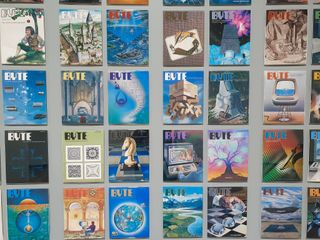See 50 glorious years of PC history at the new Computer Museum of America
"That belongs in a museum!"

I live in the northern part of the state of Georgia, about 45 minutes from Atlanta. While it is a nice place to live, there's not much in the way of interesting locations to visit. Sure, Atlanta has one of the world's largest aquariums, and there's a worse version of Mount Rushmore farther north, but I've been to those a few times. You can imagine my surprise when I learned that a computer museum opened just a short drive from my home.
The Computer Museum of America is home to an impressive collection of consumer technology from the past century, as well as more than 70 supercomputers. The collection has actually been growing for years, but only now has the museum been able to secure a permanent location—conveniently located next to a laser tag arena and a mini golf course. So, let's have a quick tour, shall we?

The first exhibit that drew my attention was the same that most of you might be the most interested in: the microcomputers! Of course, 'micro' in the meaning that the computers were smaller than a room, not ant-sized. It was great to see so many computing 'firsts' in one place—the Altair 8800 (first successful personal computer), Xerox Alto (first computer with a GUI and mouse), Magnavox Odyssey (first home game console), IBM PC (first computer with an Intel x86 processor), Apple I (first computer from Apple), and so on.










Being able to see so many retro computers was a delight, and the collection was certainly more than just the most historically-important computers. There was a large plush version of the flying toaster from After Dark, a still-wrapped copy of the infamous Microsoft Bob desktop program, Nintendo's beloved R.O.B. toy robot, a text-adventure game released by Microsoft in 1979, and an Apple-branded analog watch released by the company long before smartwatches were a thing.





The computer I was most surprised to see was the probably Apple Lisa. The Lisa is fascinating for so many reasons—it was named after Steve Jobs' daughter, it cost a staggering $9,995 in 1983 (more than $25k with inflation), its hard drives were famous for failing, and it was one of the first computers with a traditional desktop interface and floating windows, and it predated the first Macintosh by a full year. Only 10,000 units were ever sold, and Apple later created a Macintosh emulator for it and sold it as the 'Macintosh XL'.
Moving on, the museum has a giant wall of all Byte magazine covers from the '70s to the '90s. The only one I had seen before this was the smartwatch with a tiny keyboard and a tiny floppy drive with the caption 'Future computers?'.


The main attraction in this museum is the massive collection of supercomputers, spanning 50 years of history. I wasn't particularly interested in these to start with, but as it turns out, building-sized computers from Silicon Graphics, IBM, Intel, and Cray Research are fascinating. Some of these absolute units were for number-crunching, some were for graphics processing, some helped NASA reach the Moon, and some of the later models might have powered your favorite online store at one point.
The biggest gaming news, reviews and hardware deals
Keep up to date with the most important stories and the best deals, as picked by the PC Gamer team.
The stories behind most of these are fascinating, and there's more overlap with traditional PCs than I expected. For example, Intel built the iPSC/1 in 1985 to prove that many off-the-shelf processors running in parallel could do much of the same work that more complicated (and more expensive) custom-made supercomputer hardware could do. It had the same Intel 80286 CPU that was common in late-80's home computers.










One fun surprise to see was a Pixar Image Computer, an image processing workstation developed by the same company that went on to release Toy Story and all your other favorite animated movies. Fewer than 300 of these computers were ever sold. Now I really want a Pixar CRT monitor.

There's a lot more to explore at the Computer Museum of America, but I don't want to spoil the whole experience. There were plenty of items still being prepared for viewing when I had a visit (like a Pong arcade machine), so the museum will probably only get better. Have a visit the next time you're around!

Corbin is a tech journalist, software developer, and longtime PC Gamer freelance writer, currently based in North Carolina. He now focuses on the world of Android as a full-time writer at XDA-Developers. He plays a lot of Planet Coaster and Fallout and hosts a podcast all about forgotten stories from tech history.

Jen-Hsun Huang might be 'Taylor Swift but for tech', but did you know he was once praised in Sports Illustrated as being 'perhaps the most promising junior ever to play table tennis in the Northwest'?

Some high-stakes poker players are cheating with an earpiece that's 'so small that you can’t take it off with your fingers' and looks like a 'James Bond movie device'
Most Popular


